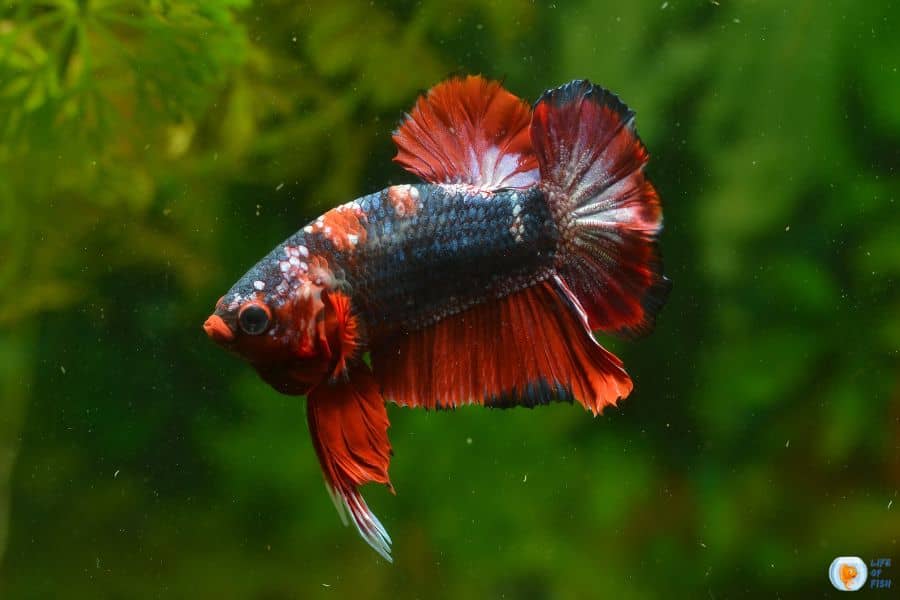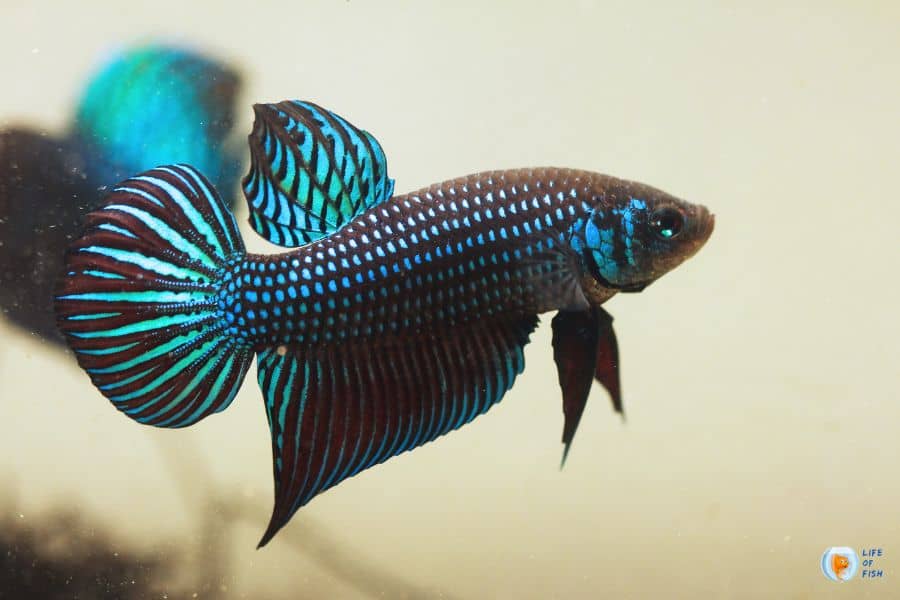Betta fish fungus is a common issue faced by many aquarium owners. As an expert in this field, I have seen firsthand the impact that betta fish fungus can have on both the health and wellbeing of your beloved pet. In this article, I’ll discuss what causes betta fish fungus, how to diagnose it, and most importantly, how to treat it.

Betta fish are naturally prone to fungal infections due to their sensitive nature and poor water conditions. Poor hygiene practices like keeping the tank too dirty or not changing the water regularly can create ideal breeding grounds for fungus growth. It’s important to be aware of these potential risks. So you can take steps to prevent them from occurring in the first place.
“Worried about your Betta Fish’s health? Our guide on Betta Fish Diseases can help you identify and treat common illnesses. Click here to read more!” Betta Fish Diseases
Definition Of Fish Fungus
Jump To
- 1 Definition Of Fish Fungus
- 2 Importance Of Understanding Fish Fungus
- 3 Types Of Fish Fungus
- 4 Causes And Symptoms Of Fish Fungus
- 5 Diagnosis And Treatment Of Fish Fungus
- 6 Diagnosis Through Visual Examination And Laboratory Tests
- 7 Can Fish Fungus Be Transferred To Humans?
- 8 How Do You Prevent Fish Fungus?
- 9 How Do You Prevent Fish Fungus?
- 10 Conclusion
Fish fungus is a common problem among betta fish owners. Yet many people don’t understand the full meaning of the term. To illustrate how serious this issue can be, I once had to euthanize one of my own betta fish due to an untreated fungal infection.
So what exactly is fish fungus? Fish Fungus is a common condition that can affect the skin, fins, and overall well-being of your fish. This condition is caused by various types of fungi and bacteria. Early detection and treatment are crucial to prevent further damage to your fish’s health.
Importance Of Understanding Fish Fungus
Understanding fish fungus is important in order to prevent, diagnose and treat any potential issues that may arise. As a betta fish owner, it is importance to understand prevention, diagnosis and treatment for their beloved pets.
Prevention includes understanding common causes of fish fungal infections such as poor water quality or overcrowding. Diagnosis requires careful observation for signs such as white spots on the skin or red streaks in the fins. Treatment typically involves a combination of medications and environmental modifications, depending on the severity of the infection.
It’s also essential to understand how certain treatments can affect your fish’s health so that you can take quick action if needed. For example, treating fin rot with antibiotics might cause more harm than good if not done properly!
Types Of Fish Fungus
There are several types of fish fungus that can affect betta fish. The most common type is columnaris, also known as cotton wool disease due to the white patches it leaves on the fish’s body and fins. Columnaris is caused by a bacteria and can be fatal if left untreated.
Another type of fungus is saprolegnia which often appears in aquariums with poor water quality or when a fish has been injured. This type of fungus looks like dark spots or patches on the skin, scales and gills of the betta fish. Finally, aeromonas is another bacterial infection that may appear as red sores or ulcers on the surface of the betta’s body or fins.
Causes And Symptoms Of Fish Fungus
Fish fungus, also known as Saprolegnia or Cotton Wool Disease, is a fungal infection that can affect any fish species. It’s important to be aware of the causes and symptoms so you can diagnose it early and take action if needed. Let’s look at an example to illustrate how serious this problem can be.
Poor Water Quality And Hygiene
Poor water quality and poor hygiene are among the most common causes of betta fish fungus. The primary culprit is a lack of cleanliness in the aquarium. It can lead to an overabundance of toxins being released into the environment. When this happens, it’s much easier for fungal spores to take hold and start growing on your fish.
To avoid this, be sure to regularly change out 25% of the tank water each week with fresh dechlorinated tap water. Additionally, use only safe cleaning products when maintaining your aquarium. And make sure any decorations or live plants you add don’t contain chemicals that could harm your fish.
Physical Symptoms Such As Lesions And Discoloration
Common physical symptoms include lesions or discoloration on the body of the fish. Lesions can be white or raised spots that may ooze a milky substance when touched. Discoloration can take forms such as brown patches or grayish-white film along the fish’s scales. If these physical symptoms of fungal infection appear, it is important to act quickly by changing the fish’s environment and providing medical care like antibiotics for treatment.
Behavioral Symptoms Such As Loss Of Appetite And Lethargy
Coincidentally, the most common behavioral symptoms of betta fish fungus are loss of appetite and lethargy. Although not always caused by a fungal infection, these signs should be taken seriously as they may indicate that something is wrong with your fish’s health.
Loss of appetite can range from mild disinterest in food to complete refusal to eat altogether. While lethargy can involve anything from reduced activity levels to refusing to move at all. Both behaviors are concerning and warrant further investigation into the possible cause.
It’s important to note that there may be other factors contributing to these changes in behavior. For instance, stress or poor water quality could lead to similar symptoms. That said, if you suspect a fungal infection it’s best to take steps towards diagnosing and treating it quickly before any more damage is done.
Diagnosis And Treatment Of Fish Fungus
Now that we’ve discussed the behavioral symptoms of betta fish fungus, it’s time to move on to diagnosis and treatment. When diagnosing a betta fish with an infection, visual examination is key.
Look for any changes in coloration or texture of the skin and gills that could indicate a fungal infection. An experienced aquarist can also look for signs such as white patches or cotton-like growths which are common indicators of fish fungus. In some cases, laboratory tests may be necessary to confirm the diagnosis.
Treating a betta fish with fungus requires consistent medication and care over several weeks. The best course of action is to remove infected fish from their tank into a separate one where they won’t infect other healthy fish.
Then administer appropriate antifungal medications according to your veterinarian’s instructions. Commonly used treatments include Pimafix, Melafix, Acriflavine and Methylene Blue solutions. All safe for use around bettas so long as you follow the manufacturer’s directions carefully.
It’s important not to miss even one dose throughout the treatment period which usually lasts between four and six weeks depending on severity. With proper care, most bettas recover fully from a fungal infection although relapses can occur if preventative measures aren’t taken after recovery has been achieved.
Diagnosis through visual examination and laboratory tests will give us more information about what type of treatment approach will work best for our betta’s particular case of fungus.

Diagnosis Through Visual Examination And Laboratory Tests
Have you ever noticed an odd white growth on the side of your betta fish? It could be a fungal infection! But how can you tell for sure? Diagnosing a fish fungus requires careful visual examination and laboratory tests.
When examining your betta fish, look carefully at any unusual-looking spots or lesions on its body. The presence of fuzzy patches that are either grayish-white or cottony in appearance is usually indicative of a fungal infection. In some cases, there may also be increased mucus production around the affected area.
If you suspect your betta has contracted a fungal infection, it is important to confirm the diagnosis through lab testing. This typically involves taking a sample from the infected spot and sending it off to a veterinary diagnostic laboratory.
A traditional microscopic analysis will then be used to examine the sample and determine if fungi are present. From there, further testing can be done to identify which type of fungus is causing the infection. So You can take appropriate actions.
Treatment Through Medication And Changes To The Environment
Once the diagnosis is made, there are a few ways to treat betta fish fungus. Medication can be used in conjunction with environmental changes to help reduce fungal growth and promote healing.
Your veterinarian might recommend Methylene Blue or Pimafix to help rid your fish of any existing infections. It’s important to follow the instructions on the medication label carefully and use it for the entire treatment period.
Additionally, you should make sure that their environment is clean and free from contaminants that could contribute to further infection. This means clearing out any decaying organic material from their tank and changing their water regularly. Also using an aquarium filter will help keep everything clean. Furthermore, making adjustments to the lighting schedule or adding air stones can also have beneficial effects on helping fight off fungal infections.
When treating a betta fish for a fungal infection, prevention through proper care and hygiene is key. Keeping up with regular maintenance like weekly water changes helps ensure that no new infections arise and keeps your betta happy and healthy!
Regularly cleaning their tank, monitoring their temperature, adjusting light exposure times when necessary, providing them with nutritious food, checking for signs of illness – all these things play an important role in preventing future illnesses from occurring.
Prevention Through Proper Care And Hygiene
Preventing betta fish fungus can be like navigating a minefield – one wrong move and your fins may not make it out unscathed. To ensure optimal health for your beloved aquatic friend, you must take certain steps to safeguard against the unwelcome visitor of fungal infection. Here are four key components to maintaining proper care and hygiene in your aquarium:
- Regular water changes: Changing 25% of the tank’s water every two weeks helps keep toxins at bay by removing debris, uneaten food, and other pollutants from accumulating in the environment.
- Adequate filtration: A good filter will help maintain clear waters and provide additional oxygen for your fish.
- Consistent temperature: Keeping steady temperatures around 76°F – 82°F prevents stress on your fish which could lead to weakened immune systems or disease outbreaks such as fungal infections.
- Fish hygiene: Properly cleaning any new items entering the tank is essential to preventing external parasites or bacteria that can cause harm. Furthermore, ensuring all decorations are free of algae growth also improves overall cleanliness within the habitat.
It goes without saying that prevention should always come first when it comes to caring for freshwater creatures; however, if despite taking these precautions an outbreak does occur, early detection is paramount. With attentive monitoring and swift action, you’ll be able to minimize any damage caused by fungal infestations before they become too severe.
Can Fish Fungus Be Transferred To Humans?
The short answer is yes, fish fungus can be transferred to humans. Fish-fungus transmission is a real concern in the aquaculture industry, as it can cause serious human-fish diseases and infections.
Although there are no reported cases of fatal fungal infection caused by betta fish fungus, that doesn’t mean that you should ignore the risk altogether. When someone has direct contact with infected water or fish, they may develop skin irritation or other health problems.

How Do You Prevent Fish Fungus?
The key to success in preventing fish fungus is vigilance and proactive action. To maintain a healthy aquarium, it’s essential to be mindful of water quality and hygiene practices. As an experienced aquarist, I cannot emphasize enough the importance of staying on top of your tank maintenance.
First, consider regular partial water changes using dechlorinated tap or conditioned bottled water that has been treated with a conditioner such as Seachem Prime. Water temperature should remain consistent within a tolerable range for betta fish (75-80F).
Test kits are available to measure pH levels, nitrate/nitrite concentrations and other parameters that can affect the health of your fish. Regularly testing these values will help you keep your tank clean and free from pathogens like fungus.
Keeping up with good cleaning habits is also important when caring for betta fish. Diligent gravel vacuumings, sponge filter replacements and general scrubbings once every week or two are all integral parts of keeping the environment safe for your pet!
Additionally, avoid overfeeding which may cause rotting food particles at the bottom of the tank – this can result in fouled water conditions if not addressed promptly. These simple steps can go a long way towards protecting your finned friends from potential fungal infections!
How Do You Prevent Fish Fungus?
Preventive care is the best way to keep your betta fish healthy and free from fungus. To do this, there are some simple, yet important steps you should take. One of the most important preventive measures is to regularly check water quality. Make sure that ammonia levels are low and the pH balance is suitable for bettas, which is between 6.5-7.2. Additionally, be sure to keep up with regular water changes in order to get rid of any toxins or bacteria that may be present in the tank.
Good hygiene practices also play an essential role when it comes to preventing fungal infections on your fish. Be sure to rinse off all new decorations before placing them in the tank as these can contain dangerous pathogens or parasites that could make your betta sick if ingested. Also, pay attention to what type of food you’re feeding your fish – look for high-quality ingredients and avoid overfeeding as too much food can induce fungal growths on their skin and fins. Finally, always use a dechlorinator when topping off tanks with tap water as chlorinated water can have damaging effects on a betta’s health and lead to infection issues down the line.
Conclusion
In conclusion, fish fungus can be a serious problem for betta owners if not addressed properly. To prevent your beloved aquatic friends from being infected with these troublesome fungi, it is essential to maintain good water quality and hygiene in the tank or bowl.
Additionally, proper care should be taken to avoid transferring any of the infectious diseases between different species of fish, as well as humans. By following all of these simple steps, you will ensure that your finned family remain happy and healthy for many years to come!
When caring for our scaly pals, we must remember: prevention is paramount when it comes to protecting them from fungal infections. Keeping tanks clean and hygienic by performing regular water changes will help reduce the risk of contamination. Additionally, adequate nutrition and a stress-free environment are also key elements in ensuring a healthy fish population free from disease causing pathogens.
Read Next: Betta Furunculosis: A Guide to Diagnosis and Treatment
Read Next: Defeating Betta Velvet Disease: The Ultimate Guide to Symptoms, Treatments and Prevention
